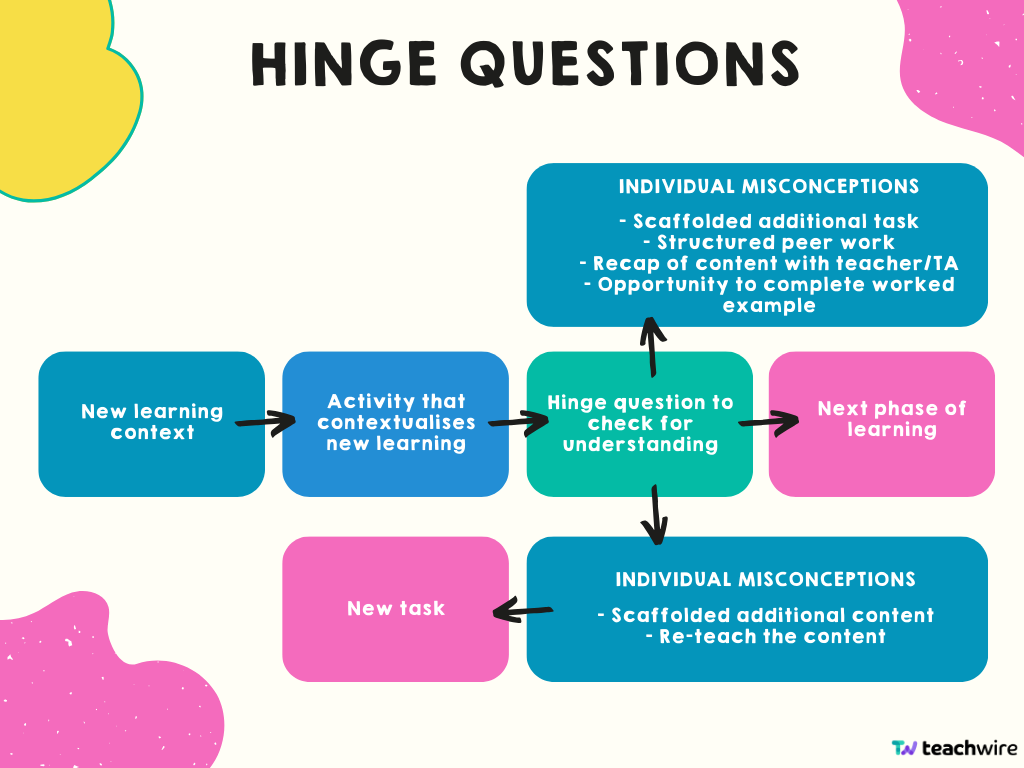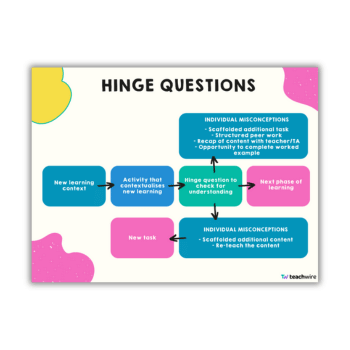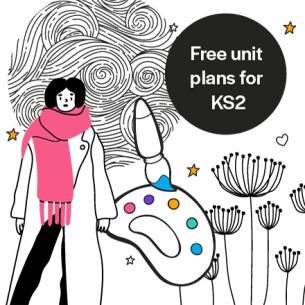PowerPoint
KS1, KS2, KS3, KS4
Years 1-11
Questioning at pivotal times during a lesson is the key to successful teaching and learning. By pre-planning specific hinge questions to check for understanding, you’re able to effectively check that the foundations of complex concepts are in place before you introduce additional learning and content.
Of course, it follows that if the foundations for learning are strong, students are more likely to effectively process additional learning.
Hinge questions are the perfect tool for assessing all pupils during your lesson. The answers that pupils give will guide you as to whether to recap or move on.
Using this powerful but relatively simple approach, you can be informed and reactive in your lesson, responding instantly to learners’ needs.
If you’re not already using planned hinge questions, you’re missing out on a hugely effective form of questioning in terms of progress and workload.
“Using this powerful but relatively simple approach, you can be informed and reactive in your lesson”
What is a hinge question in teaching?
I like to think of hinge questions as the questions you use to ‘open the door’ to the next part of the lesson. Indeed, they can either ‘open up’ new learning or remain closed, depending on the responses students give you.
This type of question can take numerous forms. However, the main concept is that you aim the question at the whole class, not just individuals. You’re assessing the progress of all, not just some.
If we question a small proportion of the class, we can quickly get a false reading on understanding. Hinge questions elicit a response from all, allowing you to assess how well students have learnt and understood key concepts.
“The main concept is that you aim the question at the whole class, not just individuals”
Although you’re asking all students, hinge questions don’t require a long response – quite the opposite, in fact. This means they can reduce workload too.
Effective questioning is an expansive topic in itself, but when you’re thinking about hinge questions during planning, it’s prudent to consider using closed-ended questioning.
Introducing a mini-diagnostic assessment is effective when there are a limited amount of potential responses. Hinge questions are incredibly specific and therefore need precise responses, from limited options.
Although you can use open-ended questions with positive effect, if you’re looking to use hinge questions in their intended form, the responses should be quick, snappy and not affect the flow of the lesson. For this reason, closed-ended questions are best.
“Hinge questions are incredibly specific and therefore need precise responses, from limited options”
Planning hinge questions

Hinge questions are most effective when you use them during a lesson, in the main body of new learning. This is opposed to at the beginning or end.
The whole point is that you introduce them at points where you need to check for progress, gaps in learning or misconceptions. Students are able to think about what they are engaging with, while you can assess progress on the spot.
Multiple choice
One of my favourite ways to package hinge questions is via a simple multiple choice quiz. Not only is it quick and easy to plan, it gives tangible results instantly with zero-effort marking.
Coupled with mini whiteboards or simple hand signals (eg ‘a’ = one finger, ‘b’ = two fingers, etc), you can conduct the exercise in seconds with a huge yield in terms of usable data. You will be able to identify students for additional support, or you can make a decision about whether a recap is more important than moving on.
When planning multiple choice questions, it’s best to include four possible answers – one correct and three distractors. It’s important to ensure that all of the distractors are at least plausible answers that address common misconceptions or errors. For example, your distractors might include:
- incorrect application of formulae
- incorrect use of logic
- misuse of specific terminology
You can use hinge questions to target specific terminology or concepts. They may take the form of a one-sentence question where you ask students to complete a task or problem.
“It’s important to ensure that all of the distractors are at least plausible answers”
Dylan Wiliam discusses the frequency of checking for understanding using hinge questions and states that the ideal frequency is:
“… at least once every 20 – 30 minutes, if you’re going to make sensible decisions about what to do next, you need to get a response from the whole class.”
Wiliam also encourages a speedy response to hinge questions. He states that teachers should be able to assess and understand the responses given from the class “in 30 seconds or less”.
When can hinge questions be used?
Hinge questions don’t need to be a part of every lesson. You might use them in lessons where you’re introducing new material or where it’s more likely that learners will have misconceptions.
Hinge questions for primary
For example, in KS2, pupils start to multiply two-digit numbers by one-digit numbers including with regrouping. A well-placed hinge question will help you identify students who are struggling to multiply by smaller numbers before you expose them to bigger numbers.
In English, if you’re teaching alliteration, you might ask a simple multiple choice question such as:
Which sentence uses alliteration?
a) It was raining hard outside.
b) The rain pattered on the open window.
c) Suddenly, the rain rushed into the river.
d) The rain washed down the street like a river.
Obviously, those who are able to identify that ‘c’ is the correct answer have shown they can pick out the desired device in context. It’s possible, of course, that a student may guess the answer, but you can follow up with a probing question if you suspect this may be the case.
Examples of hinge questions in science
Similarly, in science, when looking at sea creatures, pupils need to understand that not all animals who live in the sea are fish. This is a simplistic point, but it can be difficult to undo this misconception later when studying mammals.
How hinge questions reduce workload
Hinge questions allow instantaneous assessment, meaning that you don’t have to mark anything at a later date. The way I see it, they are a huge workload reducer.
They give you much more practical data than marking books after the lesson would. In fact, the simple process ensures you are informed in the moment and can adapt your lesson in reaction to the live feedback.
Not only does this aid you in your future planning, it also ensures all of the time you have in the classroom is directed towards the progress of students.
Final words
Hinge questions are not a silver bullet. They should complement a well-structured and thought-through lesson. By introducing them, you can quickly improve the efficiency and effectiveness of your teaching and respond instantly to emerging needs.
Hinge questions help your class to avoid misconceptions and build their confidence quickly. Meanwhile, you can rest assured that what you’re teaching is actually being learnt.
Adam Riches is a teacher, education consultant and writer.















